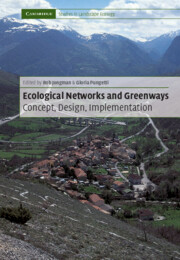Book contents
- Frontmatter
- Contents
- List of contributors
- Foreword
- Preface
- Acknowledgements
- 1 Introduction: ecological networks and greenways
- 2 The context and concept of ecological networks
- 3 Greenways in the USA: theory, trends and prospects
- 4 Ecological functioning of ecological networks: a species perspective
- 5 Impacts of roads on ecological networks and integration of conservation and transportation planning: Florida as a case study
- 6 Ecological corridors on a European scale: a typology and identification of target species
- 7 Planning the future landscape between nature and culture
- 8 From models to reality: design and implementation process
- 9 Design of the Pan-European Ecological Network: a national level attempt
- 10 Ecological ‘black spots’ within the ecological network: an improved design for rural road network amelioration
- 11 An ecological network for the Milan region based on focal species
- 12 Connecting corridors: implementing metropolitan greenway networks in North America
- 13 The Florida Statewide Greenways Project: its realisation and political context
- 14 The ecological network development in the Yungas, Argentina: planning, economic and social aspects
- 15 The river corridor of the Guadiamar
- 16 Conclusions: into the twenty-first century
- References
- Index
8 - From models to reality: design and implementation process
Published online by Cambridge University Press: 29 December 2009
- Frontmatter
- Contents
- List of contributors
- Foreword
- Preface
- Acknowledgements
- 1 Introduction: ecological networks and greenways
- 2 The context and concept of ecological networks
- 3 Greenways in the USA: theory, trends and prospects
- 4 Ecological functioning of ecological networks: a species perspective
- 5 Impacts of roads on ecological networks and integration of conservation and transportation planning: Florida as a case study
- 6 Ecological corridors on a European scale: a typology and identification of target species
- 7 Planning the future landscape between nature and culture
- 8 From models to reality: design and implementation process
- 9 Design of the Pan-European Ecological Network: a national level attempt
- 10 Ecological ‘black spots’ within the ecological network: an improved design for rural road network amelioration
- 11 An ecological network for the Milan region based on focal species
- 12 Connecting corridors: implementing metropolitan greenway networks in North America
- 13 The Florida Statewide Greenways Project: its realisation and political context
- 14 The ecological network development in the Yungas, Argentina: planning, economic and social aspects
- 15 The river corridor of the Guadiamar
- 16 Conclusions: into the twenty-first century
- References
- Index
Summary
Introduction
The concepts and models that have been developed and that have been explained in the preceding chapters should find their way into practice. The importance of models, adequate data and the translation into practice, in both design and implementation by organisations responsible for it, is pivotal for a new and improved landscape planning and nature conservation strategy. In Europe many authorities at local, regional and national level have worked out plans for ecological networks (Jongman and Kristiansen 2001). In different settings and with different budgets and constraints all governments work in the same direction of a more sustainable landscape and maintenance of natural ecosystems.
In this chapter we will show and compare the approaches in two different regions of Europe, Bologna and Modena (Northern Italy) and Gelderland (the Netherlands) using the same models and having comparable approaches in different political settings. Both regions develop ecological networks but are in a different phase and have different possibilities (Boxes 8.1 and 8.2).
The region and provinces involved have a problem in maintaining and improving biological diversity that they want to solve through the design of an ecological network. Owing to the different situations different plans are made, but with the same methodology. The general plan is made at the provincial level and plans are specified at the local level. With a practical plan that gives broad views and is worked out at the local level, it is expected that concrete steps can be set in contact with municipalities and district water boards for realising local plans and actions to improve or make new corridors.
Information
- Type
- Chapter
- Information
- Ecological Networks and GreenwaysConcept, Design, Implementation, pp. 128 - 150Publisher: Cambridge University PressPrint publication year: 2004
Accessibility standard: Unknown
Why this information is here
This section outlines the accessibility features of this content - including support for screen readers, full keyboard navigation and high-contrast display options. This may not be relevant for you.Accessibility Information
- 4
- Cited by
